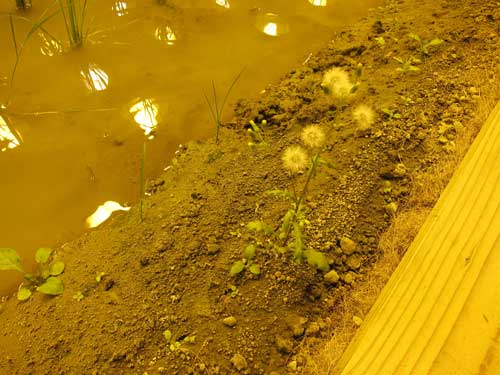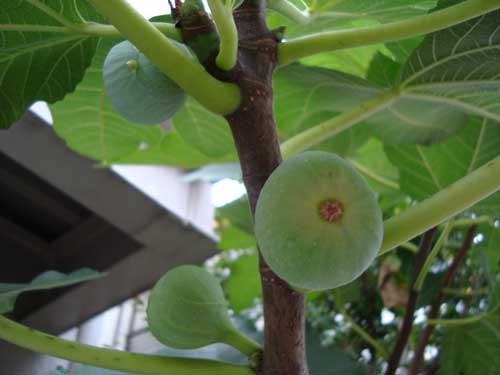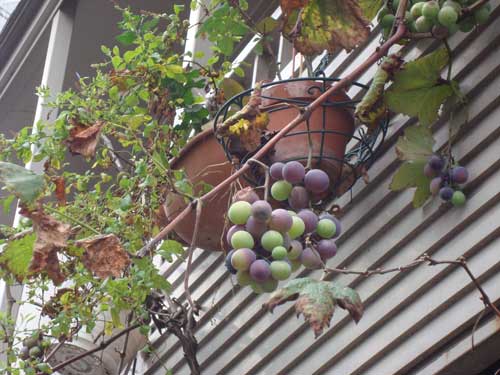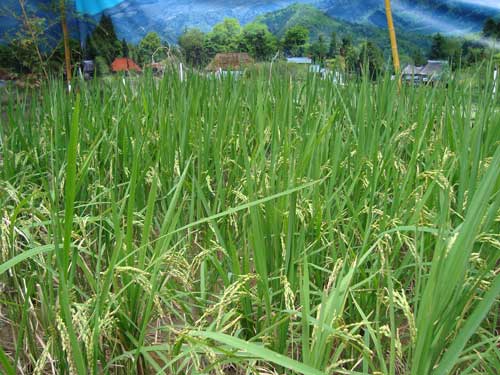
青山の小さな神社に、ザクロ果実がだんだん熟してきています。
This tiny shrine in crowded Aoyama, next to the Comme des Garcons flagship store, is full of trees, including a mature pomegranate tree. I must remember to come back and try one of these fruits.

青山の小さな神社に、ザクロ果実がだんだん熟してきています。
This tiny shrine in crowded Aoyama, next to the Comme des Garcons flagship store, is full of trees, including a mature pomegranate tree. I must remember to come back and try one of these fruits.
 東京の中には、たくさんのあまりきれいでないものがあります。とても高い電線は江戸時代の五日市街道の上を渡ります。ごみ焼却炉の煙突や高架道路やマンションの終わらない蛍光灯の列も都市生活に奇妙なリズムをつくります。このとても高い電線の下に柿の実が見えます。
東京の中には、たくさんのあまりきれいでないものがあります。とても高い電線は江戸時代の五日市街道の上を渡ります。ごみ焼却炉の煙突や高架道路やマンションの終わらない蛍光灯の列も都市生活に奇妙なリズムをつくります。このとても高い電線の下に柿の実が見えます。
There are many urban sights in Tokyo that are jarring to newcomers, perhaps none more so than the giant electricity poles. Well, there’s also garbage incinerators with tall chimneys in every neighborhood, elevated freeways, endless rows of fluorescent lights stacked high on exposed residential hallways, and the zeal for paving over almost all surfaces.
This photo was taken near Shin Koenji where the elevated main power line crosses Itsukaichi Kaido, a road that dates back to Edo and maybe earlier. You can just make out a silhouetted ripe persimmon fruit. Sometimes these unattractive elements create their own rhythm and patterns in urban life.

My watermelon plant has produced an enormous amount of growth in just two months on the balcony. It was very easy to train the vines onto the metal rod balcony. Now there are two fruits the size of oranges. I love the shape of the leaves, and am looking forward to having a watermelon party when they are ripe.
There are many previous posts about my balcony garden. It is approximately 1 meter by 6 meters, and includes the air conditioner, washer dryer, clothes line, a small stand, and about 100 plants. In addition to the permanent railing, we recently installed a summer green curtain net for extra shade and cooling.

UPDATE: I posted a revised article, “Sensing Four Seasons at a Tokyo Office Building,” on Huffington Post on July 30, 2010.
Some friends and I visited Pasona’s new office last week. They are a large Japanese staffing farm that had a highly publicized basement farm in their old Otemachi headquarters. This year they moved nearby to Yaesu in their own newly built, nine story headquarters between Tokyo Station and Nihonbashi. Pasona has unveiled a much more elaborately landscaped interior and exterior.
The image above is my favorite because it highlights the interface between the futuristic farm, dependent on a variety of grow lights including LEDs, and the urban environment outside. I am certain that the indoor vegetables will give them the most attention again, but actually I believe the exterior landscaping is more inspiring and impactful.

Below is a brief tour of interior and exterior. After the photo tour, I will suggest some metrics for judging the success of this very visible corporate monument to urban nature.
Glowing all the way across the wide downtown street even in daylight, a spectacular rice paddy with dozens of strong lights occupies the main lobby entrance of the building. The entrance doors are flanked on the outside by beautiful apple trees in giant rusted steel planters.

Almost the entire first floor of the building is devoted to the spectacle of vegetables planting, growing, and ripening under powerful grow lights: rice, tomatoes, melons, corn, eggplants, herbs, and lettuce. A large cafe features wood posts hung at angles and supporting canvas bags with soil and corn. One wall has a series of metal cases with purple lights and tiny fans that have a very “next century” feel.
There is also a room with racks and racks of lettuce, and a field of giant sunflowers. And everywhere vegetables and seedlings are arranged in attractive vignettes. Elsewhere, tomatos hang from the cut-outs in the ceiling. (Click to enlarge the photos below).




What I think works are the following:
But I also have to point out where the vision falls short.
While the indoor farm will generate the most attention for Pasona, I think that the exterior landscaping is more impressive and ultimately more interesting for urban habitat creation and the integration of nature with work space. Two thirds of the building front and at least one side have been carefully planted on handsome screened balconies to produce four seasons of color. Included are citrus trees, wisteria vines, Japanese maple, blueberries, and flowering vines like clematis. Although the plants are small now, it is easy to imagine the exterior becoming a unique vertical forest and colorful garden over the next years.
The exterior vertical landscaping has 200 species of plants, and many trees that lose their leaves in the winter. The idea is that the plant mass will reduce carbon emissions, summer shade will keep the building cooler, and winter bare branches will allow more direct light during the cold season. While the public is not invited to the upper floors, it appears that the exterior plants are all on balconies that are either accessible or viewable from inside the offices. Click below to see posters that explain the exterior landscape and the designers who worked on this project, and how the exterior garden appears from the sidewalk below.



I am looking forward to watching the exterior of the building grow into its potential. And I am eager to hear how the office workers feel about the outdoor plants that are so close to their interior work spaces.
I’ll end this post with a dandelion weed I spotted on the edge of the rice field. It is this type of unplanned feature that makes natural landscapes so enchanting.


A neighbor’s garden, which I blogged about twice before, has almost ripe fall fruit. This garden consists of no more than eight potted plants and some hanging baskets, occupying a small footprint and extending two stories up to the front entrance.
Above are figs, and below grapes. The fig tree seems to have busted its way out of the plastic pot and somehow found the soil below the street’s pavement.


On the first day of October, I visited Ginza Farm, and saw the rice is almost ready to be harvested. San Francisco Chronicle’s transportation reporter asked to interview me about Tokyo Green Space, and I thought there was no better public place to meet than Ginza Farm. The reporter’s interpreter told us that one sign that the rice is close to being ready is that the stalks start to droop under the weight of the grains.